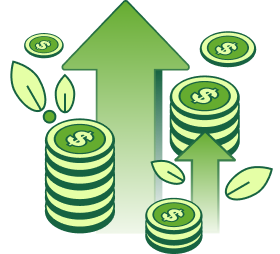Key takeaways
- Everyone can access unsecured credit cards, even with bad credit or a limited credit history.
- The best unsecured cards offer features like credit reporting and autopay to help you build credit with responsible use.
- Unsecured cards for bad credit will have higher interest rates and additional fees than cards for good to excellent scores.
When you have bad credit, your options for credit cards will be very limited. The easiest cards to get will be secured cards. The problem with secured cards is the cash deposit. Not everyone can part with a couple of hundred dollars for a few months. That’s why unsecured credit cards for bad credit are popular.
These cards give applicants with less-than-perfect scores a chance to access credit and potentially earn rewards. Use them responsibly and you’ll see your score improve.
In this article, we’ll review the different types of unsecured credit cards for bad credit and what you should consider.
Jump to:
- 5 Types of easy unsecured credit cards
- How does an unsecured credit card work?
- How to choose the best unsecured credit cards for beginners
- Is there a limit on an unsecured credit card?
- How to make the most of unsecured credit cards for bad credit
- Can I get an unsecured credit card with a 500 credit score?
- Can a secured credit card become unsecured?
- How can I get approved for a credit card with bad credit?
- Bottom line
5 Types of easy unsecured credit cards
The majority of unsecured credit cards have strict requirements. Financial institutions usually accept applicants whose scores are 690 and higher. When your credit score isn’t up to par, you won’t have as many choices, but you’re not out of options.
Here are five types of unsecured cards designed to meet the needs of those with less-than-perfect scores.
Credit cards for fair credit
Unsecured credit cards for fair credit are made for applicants whose scores fall between 580 and 669 on the FICO scale. They often have higher interest rates than cards for good to excellent credit. The credit limit will also be lower. Expect to receive an initial limit of $500 to $1,000. Some cards offer credit limits up to $2,000 and automatically consider limit increases with responsible use. The exact limit depends on your credit history, income, and debt-to-income ratio (DTI).
If you have a 600 credit score, you will likely get a card with cashback rewards and may be able to avoid paying an annual fee. The rewards rate will be modest, but at least you’re earning extra.
Credit cards for bad credit
When you have bad credit, anything below 580 on the FICO scale, secured cards will be more accessible. That said, unsecured credit cards are available for those with less-than-perfect scores. While these cards do not require an upfront deposit, they have drawbacks. Expect to pay an annual fee and an APR close to 35.99%. Many issuers will also charge a monthly fee and even a fee to open the card.
Some issuers will approve a $500 credit card limit with no deposit. A $500 limit is a decent place to start. Other issuers may only give you $300, or you may be lucky and receive a $750 credit limit. Your credit score, income, and DTI all play a role. Most issuers will do regular reviews for credit line increases. Pay your bill on time every month and keep your utilization low to be eligible.
Credit cards for no credit
Everyone starts off with no credit. Having no credit or a limited credit file means you do not have many entries on your credit report. The easiest way to fix this is to get a credit card.
The best credit cards for no credit will not charge an annual fee and will give cashback rewards. Look for cards that report to all three credit bureaus, have low APRs, and conduct account reviews to boost your limit.
Several fintech startups offer no credit check credit cards with no deposit. These alternative cards use your bank activity to determine eligibility instead of pulling your credit. They can be a low-cost way to build up your credit file.
Credit cards that accept bankruptcies
Getting a credit card after bankruptcy can be a good move. Use the card responsibly by paying it off in full each month, and it can help your credit score recover. You will have to wait for your bankruptcy to be discharged by the court before you can apply.
Once you’re eligible, look for unsecured credit cards with lenient requirements. You may see ads for guaranteed approval unsecured credit cards for bad credit that promise fast access, but be cautious. True approval is rarely guaranteed without a review. Many of these cards will have high interest rates and excessive fees.
If you can, prequalify before you apply. Prequalifying lets you gauge your chances of approval without affecting your score. The issuer will only do a soft inquiry, which does not go on your credit report. You can then compare potential offers and apply for the best one.
Credit cards to rebuild credit
The best credit cards to build credit will report your activity to all three major credit bureaus – Equifax, Experian, and TransUnion. Reporting is essential since it is the only way for the card to impact your score. They will also let you view your credit score for free each month to see your progress.
To build credit, look for cards that help you pay on time with autopay options or payment reminders. Ideally, the card will come with a high credit limit. A high limit makes it easier to maintain a low credit utilization rate. At the very least, the issuer should conduct automatic account reviews every six months to determine your eligibility for a limit increase.
Regardless of the card, responsible use, including on-time payments and keeping balances low, is key for building or rebuilding credit.
How does an unsecured credit card work?
Unsecured cards are credit cards with no deposit. They give you a revolving line of credit you can borrow against without putting down cash upfront. Approval is based instead on your creditworthiness and other financial factors.
Each billing cycle, you can spend up to your credit limit. Your issuer sets your credit limit by assessing your score, income, DTI, and other factors. As you make purchases, your available credit decreases. Repay the balance and reset your available credit.
At the end of each billing cycle, the card issuer will send you a statement showing your balance, minimum payment, and the due date. Pay the balance in full by the due date. You typically have a grace period of 21 to 25 days to pay your bill. When the grace period ends, you will accrue interest on the remaining balance.
Tired of being denied credit?
How to choose the best unsecured credit card
Choosing the right unsecured credit cards for bad credit involves several considerations:
Check your credit score: It’s essential to know your credit score before applying for any card, especially unsecured ones. This three-digit number gives lenders a quick, objective assessment of how risky a borrower you are. It is critical in determining whether you qualify for a card and the terms you receive. Knowing where you stand can help you target the right cards.
Find cards that fit your score: Only apply for cards that accept applicants in your score range. If you have a 300 credit score, you should only apply for cards that accept applicants with bad credit. Bad credit is generally considered any score under 690.
Assess interest rate: Look for credit cards with APRs below 30%. Investopedia found that cards for bad, poor, or no credit have an average APR of 26.62%.
Consider fees: Unsecured credit cards can be expensive. Many issuers charge high annual fees, monthly fees, and even a fee to open the card. Look for cards with low or no fees to minimize costs.
Read the fine print: Check the terms and conditions for hidden fees or charges. Understanding the penalty rates, interest rates, and conditions for rewards or benefits is crucial.
Credit limit and potential for increase: Many unsecured cards for bad credit will come with a low initial limit but offer increases with responsible use.
Evaluate credit building features: Prioritize cards that report your credit activity to all three credit bureaus, give you a free monthly score, and offer autopay.
Potential rewards: Some beginner cards offer modest cash back rates, which can be a nice bonus. Consider if the rewards align with your spending habits.
Need a bigger credit line?
Is there a limit on an unsecured credit card?
All unsecured cards come with a credit limit, which is the maximum amount you can charge to the card. Limits on unsecured cards vary widely based on your creditworthiness and the lender’s policies.
For those with poor scores, the initial limit will likely be low. While you will start off with a modest amount of credit, many issuers offer opportunities to increase your limit. They may automatically review your account every six months and raise your limit if you’ve consistently paid on time. You can also request a limit increase if you’ve received a raise at work or seen your score improve.
How to make the most of unsecured credit cards for bad credit
Subprime unsecured cards can be valuable for rebuilding your score when used responsibly. Here are some tips to make the most of these cards:
- Timely payments: Always pay your bill on time. Late payments can significantly damage your score. Set up autopay or put reminders in your calendar to avoid missing due dates.
- Keep balances low: Aim to keep your utilization ratio below 30%, though lower is better. If your limit is $500, keep your balance under $150. Low balances show that you are not overly reliant on lenders.
- Pay your bill in full: Paying off the entire balance each month avoids interest charges and helps keep your credit utilization low.
- Monitor your credit: Regularly check your credit report for errors and track your score. Many financial institutions offer free score monitoring tools to help you stay informed about your status.
- Use responsibly: Treat your card like a debit card. Only charge what you can afford to pay off each month to avoid accumulating debt and paying high interest rates.
- Upgrade when possible: As your score improves, consider asking for a limit increase or upgrading to a card with better terms and rewards. This can further boost your score and provide additional benefits.
By following these strategies, you can effectively use second chance credit cards with no security deposit to improve your financial health.
Can I get an unsecured credit card with a 500 credit score?
Obtaining an unsecured card with a 500 credit score is challenging but not impossible. A 500 score is considered poor by both the FICO and Vantage scoring models. With a score that low, you will need to focus your search on companies specializing in cards for bad credit. Here’s what you should look for:
Specialized cards: Look for unsecured cards specifically designed for consumers with poor credit. There’s no point in applying for a card you do not qualify for.
Pre-qualification: Many issuers let you prequalify with only a soft credit check without affecting your score. Use prequalification tools to gauge your chances of approval and identify cards you’re likely to be approved for.
Credit unions: Consider joining a credit union. These member-owned, non-profit financial institutions often have more lenient lending criteria. You may have an easier time getting unsecured credit cards for a 500 credit score with better terms.
Local bank: Banks often favor existing customers. Your banking history gives them insights into how you manage accounts and make payments. A strong banking history may offset negative credit information and make you a more attractive applicant. Besides approval, it can potentially lead to better interest rates, lower fees, or other perks.
Build and improve: If you’re initially denied, don’t get discouraged. Focus on improving your score by paying down debt, making timely payments, and reducing your utilization ratio. Over time, these actions will boost your score and increase your chances of approval.
Want to know more about credit card approval times?
Can a secured credit card become unsecured?
A secured card can potentially become unsecured over time. It all depends on the issuer and how you use the card. The first thing you need to do is consistently demonstrate responsible financial behavior. This includes making on-time payments, keeping your utilization low, and managing any other debts you may have. As you use your card responsibly, you’ll build a positive credit history and your score will improve.
The next part depends on your issuer’s policies. Some card issuers have policies that automatically review your account after a set period, typically 6 to 12 months. If your score has improved, they may offer to convert your secured card to an unsecured card. If your issuer does not automatically review your account, you can proactively request an upgrade. Contact your card issuer’s customer service to inquire about the possibility of transitioning to an unsecured card.
Once your secured card becomes unsecured, your security deposit is typically refunded. You will have to close your account in good standing, not owe any money, to get it back fully. Otherwise, your issuer may keep part of your deposit.
Dreaming of a higher limit?
How can I get approved for a credit card with bad credit?
Getting approved for a card with a poor rating is possible, but it will be more challenging. The first step is to consider improving your credit first. The higher your score, the better your chance of approval:
Review your credit report: Request your credit report from annualcreditreport.com. You are entitled to one free copy from each major credit bureau once a year. Check it for errors or inaccuracies and dispute any incorrect information you find. Getting an inaccurate missed payment off your report can immediately boost your score.
Reduce outstanding debt: Pay down existing debts to lower your utilization ratio to under 30%. A high utilization rate can drag down your score.
Get credit for other bills: Add other monthly payments to your credit reports. Reporting rent, utilities, phone bills, subscriptions, etc, will help you establish a positive payment history. You must enroll with a rent reporting company, but it can be worth it.
Start with a secured card: If you’re having difficulty getting approved for an unsecured card, consider a secured card. Secured cards require a refundable deposit, which acts as collateral and makes approval easier. Some fintech companies offer alternative cards that use your bank account as collateral. You get easier access to credit without putting down a deposit.
Become an authorized user: Being an authorized user gives you access to credit without applying. Ask a friend or family member with good credit if they can add you to their account. Your score will benefit from their positive credit history and you can use the card. Becoming an authorized user is an easy way to build credit so that you can apply on your own in the future.
Consider a store card: Store credit cards are easier to be approved for with bad credit and often have rewards or discounts for shopping at the issuing store. The drawback is that they are expensive. Most come with high interest rates, fees, and low limits. They are also closed-loop cards that you can only use at the issuing retailer or a sister franchise.
By following these steps and managing your card responsibly, you can enhance your chances of approval and rebuild your credit effectively.
Frequently asked questions
1. What is the easiest unsecured card to get?
The easiest unsecured card to get will be one that has a very low score requirement. Look for cards that accept applicants with no credit or a 300 rating.
2. Can I get an unsecured credit card with no credit?
You can get an unsecured credit card with limited to no credit history. Look for issuers that accept applicants with no credit and charge reasonable fees.
3. Is it possible to get an unsecured credit card with bad credit?
You can get an unsecured card even with a bad rating. Many financial institutions offer products specifically designed for individuals with lower scores. These cards often have higher interest rates and extra fees to offset the risk to the creditor.
Bottom line
The best credit card for you aligns with your financial habits and goals. The card should be affordable and have reasonable fees. If it has rewards, you should be able to earn them for spending that you already do. Remember that carrying a balance and accruing interest will likely negate any rewards you earned.
If an unsecured card seems too risky or expensive, consider a secured card as a viable alternative. These cards require a deposit that serves as your limit. The deposit reduces the risk to the issuer, often resulting in lower fees and interest rates. A lot of fintech companies are now offering alternative cards secured by your bank account so that you’re not tying up your money in a deposit.
Whether you choose an unsecured or secured card, always make payments on time and maintain a low usage rate. Responsibly managing your finances will lead to a higher credit score over time. As your score increases, so do your chances of securing a premium rewards card.




